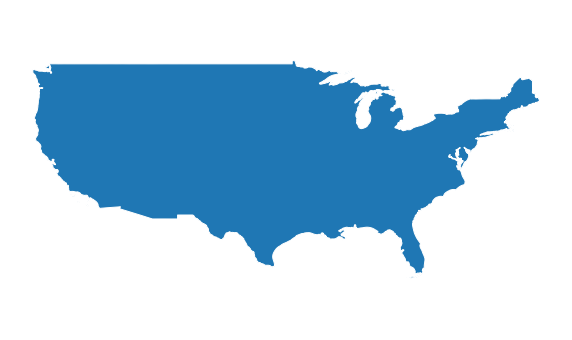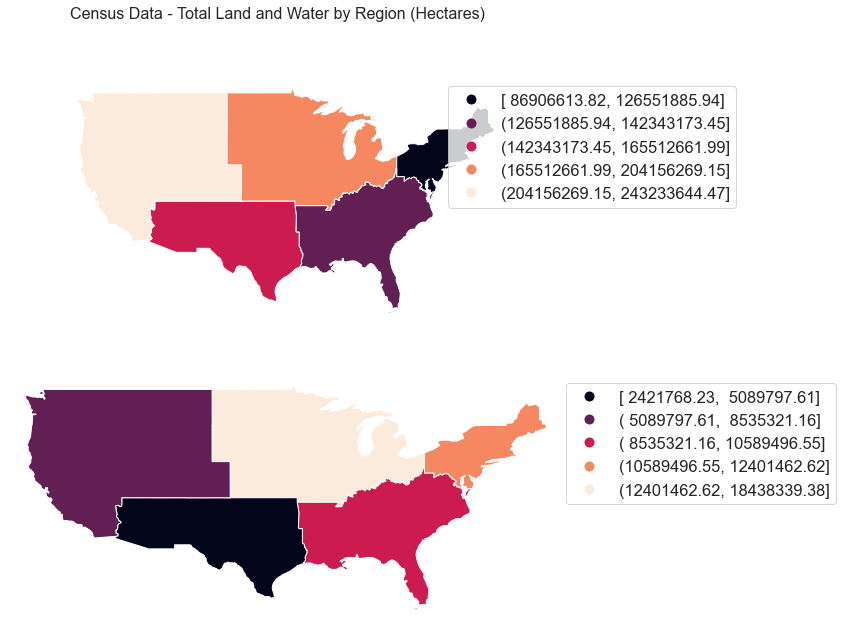Lesson 4. How to Dissolve Polygons Using Geopandas: GIS in Python
Learning Objectives
- Dissolve polygons based upon an attribute using
geopandasinPython.
Import Packages and Set Working Directory
Get started by loading your libraries and be sure that your working directory is set.
# Import libraries
import os
import numpy as np
import matplotlib.pyplot as plt
import matplotlib.lines as mlines
from matplotlib.colors import ListedColormap
import seaborn as sns
from shapely.geometry import box
import geopandas as gpd
import earthpy as et
# Adjust plot font sizes
sns.set(font_scale=1.5)
sns.set_style("white")
# Set working dir & get data
data = et.data.get_data('spatial-vector-lidar')
os.chdir(os.path.join(et.io.HOME, 'earth-analytics'))
Import Data
To begin, import the following foud shapefiles using geopandas.
# Define base path as it is repeated below
base_path = os.path.join("data", "spatial-vector-lidar")
# Define file paths
country_boundary_path = os.path.join(base_path, "usa",
"usa-boundary-dissolved.shp")
state_boundary_path = os.path.join(base_path, "usa",
"usa-states-census-2014.shp")
pop_places_path = os.path.join(base_path, "global", "ne_110m_populated_places_simple",
"ne_110m_populated_places_simple.shp")
# Import the data
country_boundary_us = gpd.read_file(country_boundary_path)
state_boundary_us = gpd.read_file(state_boundary_path)
pop_places = gpd.read_file(pop_places_path)
Dissolve Polygons Based On an Attribute with Geopandas
Next, you will learn how to dissolve polygon data. Dissolving polygons entails combining polygons based upon a unique attribute value and removing the interior geometry.

Below you will dissolve the US states polygons by the region that each state is in. When you dissolve, you will create a new set polygons - one for each regions in the United States.
To begin, explore your data. Using .geom_type you can see that you have a mix of single and multi polygons in your data. Sometimes multi-polygons can cause problems when processing. It’s always good to check your geometry before you begin to better know what you are working with.
state_boundary_us.head()
| STATEFP | STATENS | AFFGEOID | GEOID | STUSPS | NAME | LSAD | ALAND | AWATER | region | geometry | |
|---|---|---|---|---|---|---|---|---|---|---|---|
| 0 | 06 | 01779778 | 0400000US06 | 06 | CA | California | 00 | 403483823181 | 20483271881 | West | MULTIPOLYGON Z (((-118.59397 33.46720 0.00000,... |
| 1 | 11 | 01702382 | 0400000US11 | 11 | DC | District of Columbia | 00 | 158350578 | 18633500 | Northeast | POLYGON Z ((-77.11976 38.93434 0.00000, -77.04... |
| 2 | 12 | 00294478 | 0400000US12 | 12 | FL | Florida | 00 | 138903200855 | 31407883551 | Southeast | MULTIPOLYGON Z (((-81.81169 24.56874 0.00000, ... |
| 3 | 13 | 01705317 | 0400000US13 | 13 | GA | Georgia | 00 | 148963503399 | 4947080103 | Southeast | POLYGON Z ((-85.60516 34.98468 0.00000, -85.47... |
| 4 | 16 | 01779783 | 0400000US16 | 16 | ID | Idaho | 00 | 214045425549 | 2397728105 | West | POLYGON Z ((-117.24303 44.39097 0.00000, -117.... |
state_boundary_us.geom_type.head()
0 MultiPolygon
1 Polygon
2 MultiPolygon
3 Polygon
4 Polygon
dtype: object
Next, select the columns that you with to use for the dissolve and keep. In this case we want to retain the:
- LSAD
- geometry
columns.
state_boundary = state_boundary_us[['LSAD', 'geometry']]
cont_usa = state_boundary.dissolve(by='LSAD')
# View the resulting geodataframe
cont_usa
| geometry | |
|---|---|
| LSAD | |
| 00 | MULTIPOLYGON Z (((-81.81169 24.56874 0.00000, ... |
And finally, plot the data. Note that when you dissolve, the column used to perform the dissolve becomes an index for the resultant geodataframe. Thus you will have to use the reset_index() method when you plot, to access the region “column”.
So this will work:
us_regions.reset_index().plot(column = 'region', ax=ax)
This will return an error as region is no longer a column, it is an index! us_regions.plot(column = 'region', ax=ax)
cont_usa.reset_index()
| LSAD | geometry | |
|---|---|---|
| 0 | 00 | MULTIPOLYGON Z (((-81.81169 24.56874 0.00000, ... |
# Plot the data
fig, ax = plt.subplots(figsize=(10, 6))
cont_usa.reset_index().plot(column='LSAD',
ax=ax)
ax.set_axis_off()
plt.axis('equal')
plt.show()

Dissolve and Aggregate Data
In the example above, you dissolved the state level polygons to a region level. However, you did not aggregate or summarize the attributes associated with each polygon. Next, you will learn how to aggregate quantitative values in your attribute table when you perform a dissolve. To do this, you will add
aggfunc = 'fun-here'
to your dissolve call. You can choice a suite of different summary functions including:
- first
- last
- mean
- max
And more. Read more about the dissolve function here.
Below the data are aggregated by the ‘sum’ method. This means that the values for ALAND are added up for all of the states in a region. That summary sum value will be returned in the new dataframe.
# Select the columns that you wish to retain in the data
state_boundary = state_boundary_us[['region', 'geometry', 'ALAND', 'AWATER']]
# Then summarize the quantative columns by 'sum'
regions_agg = state_boundary.dissolve(by='region', aggfunc='sum')
regions_agg
| geometry | ALAND | AWATER | |
|---|---|---|---|
| region | |||
| Midwest | MULTIPOLYGON Z (((-87.80048 42.49192 0.00000, ... | 1943869253244 | 184383393833 |
| Northeast | MULTIPOLYGON Z (((-76.04621 38.02553 0.00000, ... | 869066138232 | 108922434345 |
| Southeast | MULTIPOLYGON Z (((-81.81169 24.56874 0.00000, ... | 1364632039655 | 103876652998 |
| Southwest | POLYGON Z ((-94.48587 33.63787 0.00000, -94.41... | 1462631530997 | 24217682268 |
| West | MULTIPOLYGON Z (((-104.05325 41.00141 0.00000,... | 2432336444730 | 57568049509 |
# Convert area units from square meters to hectares (divide by 10,000)
regions_agg["land_ha"] = regions_agg["ALAND"] / 10000
regions_agg["water_ha"] = regions_agg["AWATER"] / 10000
regions_agg
| geometry | ALAND | AWATER | land_ha | water_ha | |
|---|---|---|---|---|---|
| region | |||||
| Midwest | MULTIPOLYGON Z (((-87.80048 42.49192 0.00000, ... | 1943869253244 | 184383393833 | 1.943869e+08 | 1.843834e+07 |
| Northeast | MULTIPOLYGON Z (((-76.04621 38.02553 0.00000, ... | 869066138232 | 108922434345 | 8.690661e+07 | 1.089224e+07 |
| Southeast | MULTIPOLYGON Z (((-81.81169 24.56874 0.00000, ... | 1364632039655 | 103876652998 | 1.364632e+08 | 1.038767e+07 |
| Southwest | POLYGON Z ((-94.48587 33.63787 0.00000, -94.41... | 1462631530997 | 24217682268 | 1.462632e+08 | 2.421768e+06 |
| West | MULTIPOLYGON Z (((-104.05325 41.00141 0.00000,... | 2432336444730 | 57568049509 | 2.432336e+08 | 5.756805e+06 |
fig, (ax1, ax2) = plt.subplots(2, 1, figsize=(10, 10))
regions_agg.plot(column='land_ha',
legend=True,
scheme="quantiles",
ax=ax1)
regions_agg.plot(column='water_ha',
scheme="quantiles",
legend=True,
ax=ax2)
plt.suptitle('Census Data - Total Land and Water by Region (Hectares)', fontsize=16)
leg = ax1.get_legend()
leg.set_bbox_to_anchor((1.5,1))
leg = ax2.get_legend()
leg.set_bbox_to_anchor((1.5,1))
ax1.set_axis_off()
ax2.set_axis_off()
plt.axis('equal')
plt.show()

Share on
Twitter Facebook Google+ LinkedIn
Leave a Comment